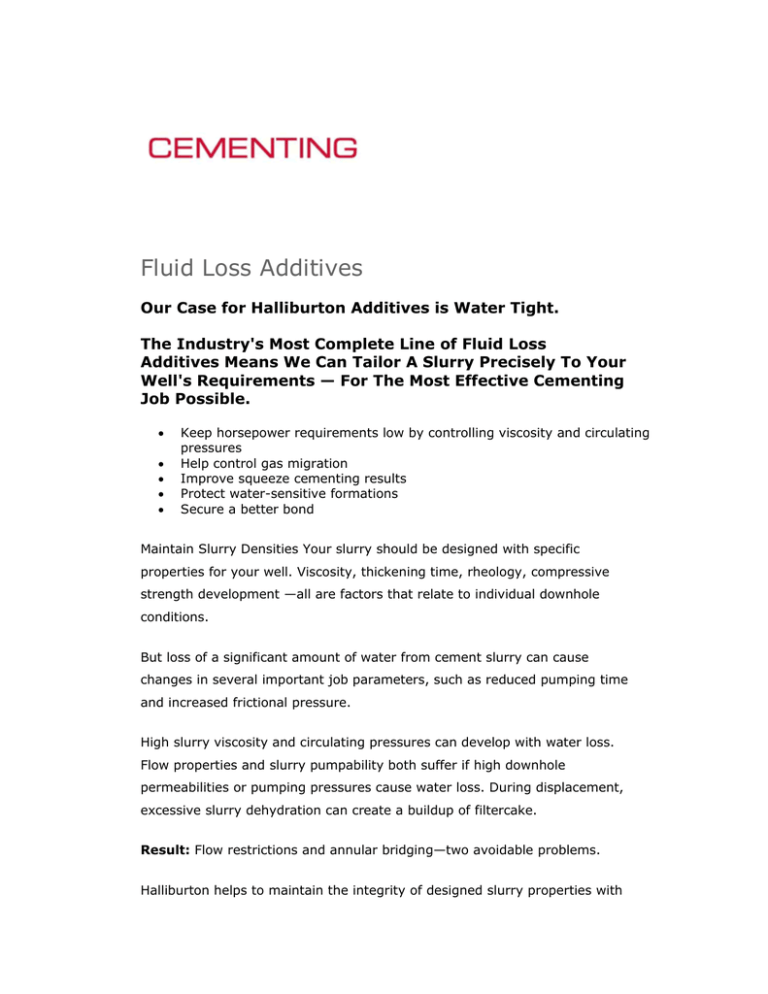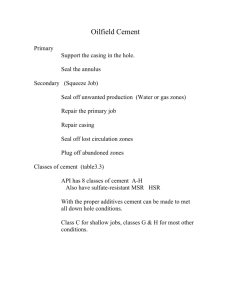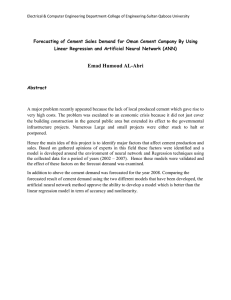
Fluid Loss Additives
Our Case for Halliburton Additives is Water Tight.
The Industry's Most Complete Line of Fluid Loss
Additives Means We Can Tailor A Slurry Precisely To Your
Well's Requirements — For The Most Effective Cementing
Job Possible.
•
•
•
•
•
Keep horsepower requirements low by controlling viscosity and circulating
pressures
Help control gas migration
Improve squeeze cementing results
Protect water-sensitive formations
Secure a better bond
Maintain Slurry Densities Your slurry should be designed with specific
properties for your well. Viscosity, thickening time, rheology, compressive
strength development —all are factors that relate to individual downhole
conditions.
But loss of a significant amount of water from cement slurry can cause
changes in several important job parameters, such as reduced pumping time
and increased frictional pressure.
High slurry viscosity and circulating pressures can develop with water loss.
Flow properties and slurry pumpability both suffer if high downhole
permeabilities or pumping pressures cause water loss. During displacement,
excessive slurry dehydration can create a buildup of filtercake.
Result: Flow restrictions and annular bridging—two avoidable problems.
Halliburton helps to maintain the integrity of designed slurry properties with
a complete line of fluid loss additives for virtually any well. These additives
are particularly important in two specialized areas: squeeze cementing and
annular gas migration control.
Squeeze Cementing
Remedial operations requiring special slurry properties and placement
techniques use pumping pressures and controlled fluid in a number of
different areas of application, including:
•
•
•
•
•
Plugging perforations into depleted or non-productive zones
Repairing damaged casing
Filling uncemented voids in the cement sheath
Shutting off water flow
Sealing thief zones
Fluid loss control in a slurry placed under squeeze pressures is a critical
concern because under such pressures, a slurry can dehydrate quickly and
become unpumpable, preventing the extension of slurry into voids and
channels.
Additives that control water loss contribute to the formation of an extremely
dense layer of compacted cement solids that build an impenetrable barrier
into and across the area of application. Inside the pipe, the cement slurry
remains fluid, thus allowing: 1) a long interval of perforations to be sealed in
one operation and, 2) permitting the possibility for cement to be reverse
circulated out of the casing or tubing, thereby eliminating the need for
drilling out.
Annular Gas Migration Control
Including a fluid loss additive in the cement composition can be very
important in avoiding gas migration problems. A fluid loss additive reduces
slurry volume loss and the resulting hydrostatic pressure losses in the
cement column created by loss of water from the cement slurry.
Halliburton's exclusive GASFLO computer program can be used to calculate
the probability and potential severity of annular gas migration. The computer
uses input of well data to calculate and assign a numerical value to the
potential for gas flow. With a low flow potential factor the optimal solution is
a controlled fluid loss cement slurry that can be highly successful in
controlling the risk of gas migration.
Gas migration control is also achieved by fluid loss additives as a result of
reduction of free water from the cement slurry. A recognized cause of
cementing failure, particularly in deviated well cementing, is free water
breakout from the cement column. In deviated well conditions, free water
rises to the high side of the annulus leaving a continuous, uncemented
channel which could become a conduit for the migration of well fluids. Most
fluid loss additives act to prevent free water separation by helping maintain
suspension of cement solids until hydration begins.
How Dehydration Can Cause Gas Cut Cement
Problems...
1. The
hydrostatic
head of the
full cement
column will
usually hold
gas (yellow)
in the formation while
cement sets.
2. But, a low
pressure or
thief zone
(blue) can
allow water to
escape from
the cement
column...
3. Causing a
bridge of
dehydrated
cement to
form.
4. Because the
bridge
supports the
weight of the
column above
it, the
hydrostatic
head below the bridge is
substantially reduced.
5. In turn,
the gas you
expected the
hydrostatic
head to hold
begins to
bubble up
through the cement.
6. Eventually,
with sufficient
pressure, the
gas may break
through and
create flow
channels to the
surface.
Squeeze Cementing
Advantages of Low Fluid Loss
•
•
•
•
•
•
Reduces premature dehydration in tubing and
casing while squeezing perforations
Long perforated intervals can often be successfully
squeezed in a single stage
Satisfactory squeeze results at low pressures
without over displacing
High pressure squeezing by hesitation technique
with filter-cake buildup in perforations
Helps protect water sensitive shale sections that
may weaken and break down due to cement filtrate
Reduces the amount of filtrate which can penetrate
formations containing bentonite clays
Primary Cementing
Advantages of Low Fluid Loss
•
•
•
•
•
Lessens the possibilities of water and/or emulsion
blocks, and blocks caused by bentonitic clay
swelling due to filtrate from cement
Helps protect water sensitive shales
Reduces premature bridging in annuli, which may be caused by dehydration
Reduces loss of water from slurry thu maintaining lower viscosities and
circulating pressures
Aids in the control of gas leakage during setting of cement
www.Halliburton.com
Send questions or
comments about this site to
Halliburton Service Center
or
call U.S. (877) 263-6071 or
outside U.S. (281) 9834900.
Copyright © 2008
Halliburton. All Rights
Reserved.
Privacy







